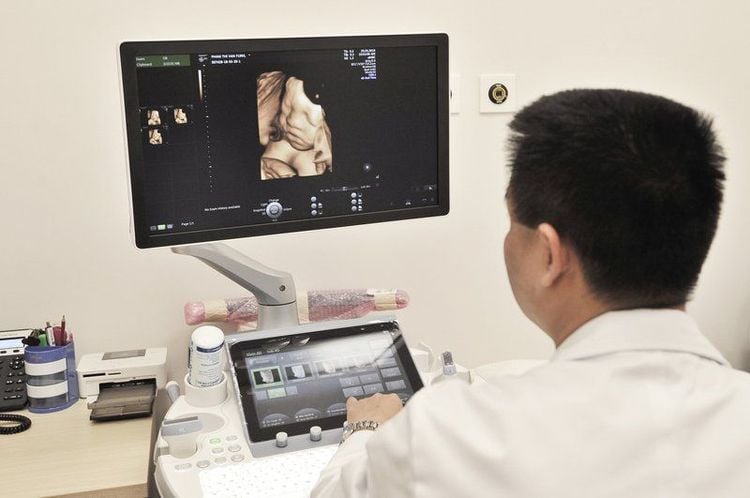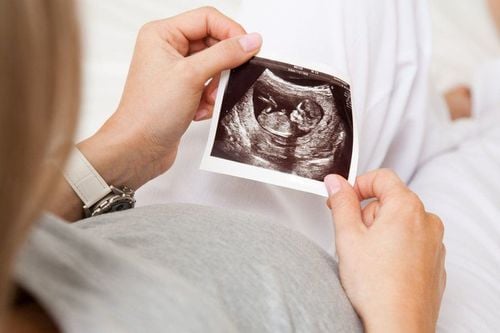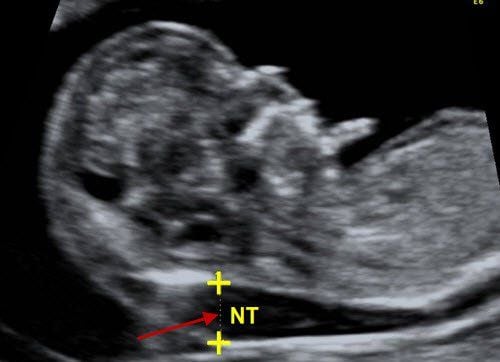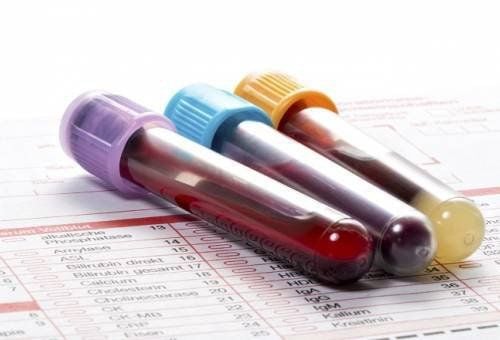This is an automatically translated article.
The article was professionally consulted by Specialist Doctor I Le Hong Lien - Department of Obstetrics and Gynecology - Vinmec Central Park International General Hospital.Measuring nuchal translucency is necessary and very important in monitoring fetal development. Usually at 11-14 weeks of pregnancy, pregnant women will be assigned by a doctor to measure nuchal translucency. Based on the results of the nuchal translucency measurement, the doctor will make a diagnosis of the fetal condition, if the results are abnormal, some other tests will be performed to get the most accurate results.
1. Why measure nuchal translucency?
The nuchal translucency ultrasound is the first screening test to screen the fetus for chromosomal abnormalities, birth defects, and thus to have an accurate plan during pregnancy.Nuchal translucency measurement will be performed from 11-14 weeks of pregnancy for the most accurate results. If measured before the 11th week of pregnancy, the fetus is still too small, so the skin on the nape of the neck will be very fuzzy, making the results inaccurate. If the measurement is taken at 14 weeks, the measurement results will no longer be meaningful. Therefore, pregnant women need to pay special attention to the important time to perform the nuchal translucency test from 11 to 14 weeks of pregnancy.
If fetal ultrasound is performed for normal indicators, mothers can rest assured. However, when the thickness of the nape skin increases, the risk of chromosomal abnormalities is higher along with other abnormalities in body structure.

2. Types of malformations caused by chromosomal abnormalities in the fetus
For normal people, there are 46 pairs of chromosomes divided into 22 pairs of autosomes and 1 pair of sex chromosomes. Birth defects for the fetus will occur when there is any change in the chromosomes. Such as single gene disorder, increased number of chromosomes...Down syndrome is the most common chromosomal disorder in children.
Here are 3 abnormal chromosome pairs that cause birth defects:
Pair of chromosomes 21 (trisomy 21): Still commonly known as Down syndrome. This is a concern of many pregnant mothers because it is the most common birth defect in the fetus, with an incidence of about 1 in 600 babies per year. Having this syndrome, the child will have intellectual disability, physical retardation or may have some heart defects. Pair of chromosomes 18 (trisomy 18): Commonly known as Edward's syndrome (excess of chromosome 18). Children with this defect cause the mother to have an early miscarriage. If this condition is not detected early, when the baby is born, he or she will carry a lot of serious defects in body structure such as small chin, umbilical hernia, crooked arms, etc., which can cause death after birth. Pair of chromosomes 13 (trisomy 13): commonly known as Patau syndrome. Children with this disability often carry a lot of defects in their bodies and life expectancy is not high. Babies with this syndrome are more likely to have a stillbirth or miscarriage.
Trắc nghiệm: Độ mờ da gáy ở thai nhi bao nhiêu là bình thường?
Trong thời kỳ mang thai, việc khám thai theo lịch của bác sĩ là vô cùng quan trọng. Trong đó, độ mờ da gáy được nhiều mẹ bầu quan tâm vì chỉ số này sẽ thể hiện rõ nguy cơ bị hội chứng Down của thai nhi. Vậy độ mờ da gáy bao nhiêu là bình thường, hãy cùng tìm câu trả lời trong bài trắc nghiệm dưới đây.3. What to do when the nuchal translucency measurement result is abnormal?
Nuchal translucency measurements can accurately diagnose about 75% of the child's risk of Down syndrome. There are still cases (small probability), children are at high risk of birth defects but are born completely normal, on the contrary, some children have nuchal translucency measurement results within safe threshold but still can malformations after birth. Therefore, to get the most accurate results, pregnant women need to perform other screening tests.If the nuchal translucency measurement result is 1.3mm, it shows that the fetus has a very low risk of Down syndrome. For fetuses with nuchal translucency of 2.6 mm, it is still within the safe threshold. Usually the result is less than 3mm, mothers should not be too worried because the risk of Down syndrome is very low. If the nuchal translucency measurement results are from 3.5mm-4.4mm, there may be a chromosomal abnormality of about 21.1%. If the nuchal translucency is 5mm thick, the child has a high risk of having Down syndrome, to be exact, other tests need to be done. If the nuchal translucency measurement result is >6.5mm, the chromosomal abnormality rate is up to 64.5%. In order to make an accurate diagnosis when nuchal translucency measurement results are abnormal, additional prenatal screening should be performed because nuchal translucency measurement is not the only method for detecting fetal malformations. Your doctor will order you to perform a double test to combine and give the probability of risk of birth defects in the first trimester. Fetal from 16-18 weeks, triple test can be combined to identify Down's disease and neural tube defects. When the nuchal translucency of the fetus is within the safe threshold, double test or triple test If all of them have a normal index, the chance of a normal birth will reach the rate of 99.7-99.8%. If your nuchal translucency measurement results are abnormal, even though the two tests above still produce normal results, you need to do another test.

Besides, pregnant mothers can perform amniocentesis and placental biopsy, however, these methods have a higher risk, the risk that mother and baby face when performing these tests. invasiveness will also be higher than that of NIPT.
If performing all the above tests and the results still show that the child has Down, then you need to listen to the doctor's analysis to give yourself the final result. If the baby has other defects or has a serious heart defect, then considering a termination of pregnancy at this time may be a necessary solution and should be done.
At Vinmec International General Hospital, besides the nuchal translucency measurement method, Vinmec also has all the prenatal screening methods to detect other fetal abnormalities such as amniocentesis, placental biopsy, NIPT ,...
These tests are performed by a team of professional doctors and nurses with the support of modern equipment to ensure high reliability, is a comprehensive and effective solution for mothers and babies. baby in pregnancy.
Please dial HOTLINE for more information or register for an appointment HERE. Download MyVinmec app to make appointments faster and to manage your bookings easily.














